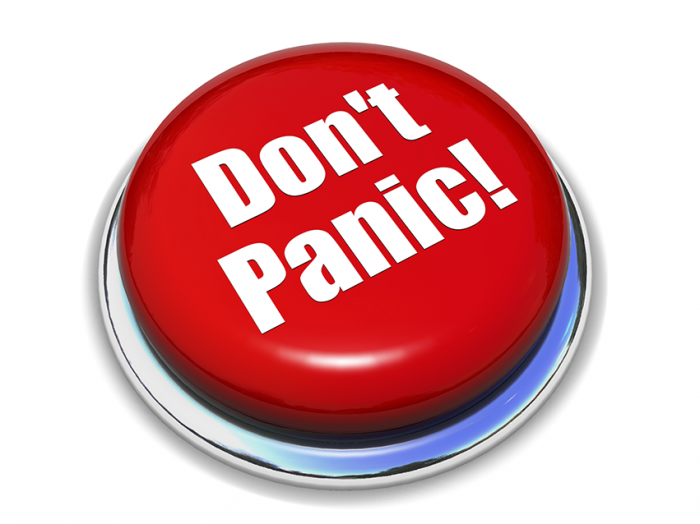A panic attack is a sudden feeling of intense fear or discomfort that causes such distress that the person having the attack fears they are losing control or dying. The attack occurs without warning, and can even wake a person from a sound sleep.
It is estimated one-third of individuals at some point in their lives experience a panic attack, often between the ages of 15-19.2 Of those who experience panic attack symptoms, less than 3% will progress to a panic disorder.3
Description of panic attack symptoms
A panic attack will have at least four of the symptoms below:1

For many people, panic attacks are a terrifying experience - typically they can last 10-20 minutes and are not life threatening.
- Pounding, racing heart
- Sweating
- Shaking
- Shortness of breath
- Choking sensation
- Chest discomfort
- Nausea
- Dizzy, feeling faint
- Feelings of unreality or detached from self
- Tingling or numbness
- Chills or heat sensations
- Fear of "going crazy"
- Fear of dying.
Although it is a terrifying event for the individual experiencing it, a panic attack typically lasts from only 10-20 minutes and is not life threatening. There is no pattern to panic attacks; some people may experience several in a day and go months without a reoccurrence, while others may have attacks on a weekly basis.
Because panic attacks can mimic other health conditions, it is necessary for anyone experiencing these symptoms to be evaluated by a health care professional to determine if there is an underlying medical cause. Certain heart problems, respiratory conditions, hormone irregularities, and stimulants like caffeine can all cause similar symptoms as seen with a panic attack.3
History of panic in medicine
Doctors first identified "panic attack" as a diagnosis around the mid 19th century. The origin of the word "panic" can be traced back to Greek mythology and the legend of Pan - a demigod whose unseen rustlings in the woods and brush would invoke irrational fear in those passing by - causing them to flee in fright or panic.4
Neurobiology of panic
A panic attack occurs when something triggers fear, also known as the fight-or-flight system. The body's nervous system releases the hormone adrenaline, and the surge of adrenaline causes disturbing feelings and sensations.
When the nervous system reacts normally to a fearful situation - once the fear is removed - adrenaline levels quickly adjust back to baseline. This does not happen with a panic attack, and a person may take an hour or more to recover fully from the symptoms.
Often there is no obvious reason for the panic symptoms, which causes the brain to explain the attack with irrational thoughts such as, "I must be dying," or "I am losing my mind." A panic attack can also be triggered by an event such as public speaking or flying.
The part of the brain called the amygdala is the cause of panic attacks and anxiety disorders.5 The amygdala - also known as the fear center - reacts with a high-stress response when exposed to an unfamiliar situation or after facing a stressful life event.
It is not fully understood why panic attacks occur, but research indicates that a combination of genetic, biological, psychological, and environmental factors can make an individual more prone to panic. For example, brain wiring that is overly sensitive to a fear stimulus and PH changes, and an amygdala that reacts to subtle changes in carbon dioxide (CO2).
Catastrophic thinking is another possible factor for panic. This is where a person's first thought is the worst - chest discomfort is a heart attack, a headache means a brain tumor, a noise in the middle of the night is a burglar.
Finally, being female, a teen or young adult, and having a traumatic event occur during childhood may make a person more vulnerable to a panic attack.6
If there is good news to deliver about panic attack symptoms, it is that they are very treatable. There are many options that can be used to keep them under control.
How to control panic attack symptoms
After a proper medical examination rules out any underlying medical disorder associated with the symptoms, panic attack symptoms can be controlled in several ways:

Calm breathing can help subside the symptoms of a panic attack - the goal is to allow a slow stream of air to come in and out.
Education
Knowledge is a huge part of overcoming panic attack symptoms. Learning how the brain's fear center works can empower people to recognize a panic attack for what it is: a misfiring of the amygdala that causes a surge of adrenaline.
It is vital to understand that the symptoms of panic are not associated with a serious illness. Despite how terrifying the symptoms of panic may feel, an attack will not lead to death.
Calm breathing
Our instinct is to breathe faster when hit with panic. Taking control of our breathing is the first step to controlling a panic attack. The goal is to allow a slow stream of air to come in and out, avoiding hyperventilation and too much carbon dioxide.
Take slow, regular breaths in through your nose and out through slightly puckered lips. Breathe in for the count of five, hold for one second, and then exhale slowly to the count of four - pause for two seconds, and then repeat. Do this for several cycles or until you feel your body start to calm down.
Muscle relaxation
Another helpful strategy involves learning to relax your body. This technique involves tensing various muscles and then relaxing them to help lower overall tension and stress levels, which can contribute to panic attacks. Start with your feet and work your way up to your forehead.
Tighten the muscle while taking a deep breath in, hold for a few seconds and then release the tension while breathing out. Move up the body, one muscle group at a time.
Mindfulness and cognitive behavioral therapy
Mindfulness is simply living life in the present moment and accepting thoughts as they come, but not letting them blow out of proportion. Panic attacks can originate from thoughts that spiral into catastrophic worries. Cognitive behavior therapy (CBT) is an effective, lasting treatment for controlling panic attack symptoms.7
CBT is similar to mindfulness, and is ideal for people who have had more than one panic attack episode. CBT challenges a fearful thought - what are you afraid will happen? Is there evidence to support these fears? A practitioner trained in CBT can help you get started and equip you with the tools to successfully control and prevent a full-blown panic attack.
Exercise
Regular exercise is necessary for maintaining good health and should be incorporated into our daily lives. From neighborhood walks to competitive sports, finding an activity of interest is important. Exercise helps rid unwanted stress and encourages the body to produces natural chemicals (endorphins) that are vital for pain relief and a feeling of well-being.
Planning ahead
If you know certain situations invoke fear, or you remember feeling panicky before, a little preparation can be helpful - you will not pass out, and no one will notice your panic. Panic attacks will not cause you to "go crazy" in public.
What is it about the situation that makes you terrified? If it is flying, talk to a friend who loves to fly and ask what they enjoy about it. Perhaps meeting the pilot and letting the flight attendant know you are scared can reassure you.
Other things you can do to help yourself is to use distractions such as music, dressing in layers or have a personal sized fan to keep you from feeling too hot, consciously start relaxation breathing, and always have water on hand to keep hydrated. Also, do not forget to reassure yourself with statements like "I am safe," "I can handle this," "I am going to be fine," or "I have got this."
Eat a healthy diet
Eat regular meals to maintain normal blood sugar levels.
- Never go more than four hours without eating
- Correct any dietary deficiencies
- Avoid caffeine and alcohol as they can trigger or make panic attack symptoms worse.
Be healthy
If you have neglected your health, now is the time to do something. Attend to any medical problems that were identified such as anemia, high blood pressure, or breathing disorders.
Smoking is a significant health hazard and contributor to panic, and should be stopped. Smoking may feel like it initially helps manage feelings of anxiety, but any small relaxation that it offers is trumped by the length of serious illnesses cigarette smoking is associated with.
Complementary and alternative medicine
There is a growing interest in using alternative medicine interventions in the US for both medical and anxiety related disorders. Use of acupuncture, aromatherapy, naturopathy, and herbs can be an effective means of controlling panic.8
Medication
Medication should not be used as initial management for panic attack symptoms, but reserved for when the above measures have not helped.
Some medications that have been successful in controlling panic attacks include antianxiety, antidepressant, and beta-blocker medications.9
Whether you or someone you know has had panic attack symptoms, it is essential to have a strong and reassuring support network.
Panic attacks are a common problem that millions of people have experienced. Although they can be terribly frightening, they are not life threatening, and they can be successfully controlled.
References:
1.
American Psychiatric
Association, Diagnostic and Statistical Manual of Mental Disorders, Fifth
(DSM-5), American Psychiatric Association, Arlington, VA 2013.
2.
Panic disorder:
epidemiology, pathogenesis, clinical manifestations, course, assessment, and
diagnosis, Katon, Wayne, MD, et al., UptoDate.com, 10 October 2014, accessed 23
February 2015.
3.
The epidemiology of
panic attacks, panic disorder, and agoraphobia in the National Comorbidity
Survey Replication, Kessler, Ronald C. et al., Archives
of general psychiatry, 63.4 (2006): 415–424. PMC, accessed 26
February 2015,abstract.
4.
Panic disorder in the
medical setting, Rockville, MD: U.S. Dept. of Health and Human Services, Katon,
Wayne, MD, Public Health Service, Alcohol, Drug Abuse, and Mental Health
Administration, National Institute of Mental Health, 1989.
5.
The amygdala is a
chemosensor that detects carbon dioxide and acidosis to elicit fear behavior,
Ziemann, Adam E. et al., Cell 139.5
(2009): 1012–1021. PMC, accessed 22 February 2015.
6.
Neurobiology of panic
and pH chemosensation in the brain, Wemmie, JA, Dialogues
in Clinical Neuroscience, 2011;13(4):475-483, 24 February 2015, abstract.
7.
Anxiety disorders,
University of Maryland Medical Center, accessed 25 February 2015.
8.
Scalp
acupuncture treatment protocol for anxiety disorders: A Case Report, Yuxin, He,
et al., Glob Adv Health Med. July (2014): 35-39, accessed 24 February
2015, abstract.
9.
Panic attacks causes, symptoms, treatment,
EMedicineHealth, accessed 26 February 2015.



No comments:
Post a Comment